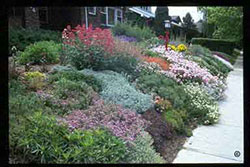Why is watering my landscape important?
Colorado’s Front Range receives an average of less than 15 inches of rain a year, making supplemental watering a necessity for most landscapes. More than half of the water used in homes is applied to landscapes. That’s why landscaping for water conservation is so important.
What should I think about when planning xeriscape?

By applying the principles of xeriscape, a landscape can be beautiful and diverse while using less water. Planning a landscape, improving the soil, choosing appropriate plants, and proper watering, mulching and maintenance all play a role in conserving water.
How do I improve my soil?
Plan and design a landscape before investing time and money. When a plan has been perfected, start a xeriscape by improving the soil. Mix organic material into the soil to make it rich and productive.
What can I choose for landscape to improve water conservation?
Choose water conserving types of grass, such as buffalo or blue grama. Mulched areas, decks and paths are alternatives to grass. Mulches cover the soil and minimize evaporation, reduce weeds and slow erosion.
Many beautiful plants that don’t require much water are available at local nursery or garden centers. After selecting plants, plan for their water needs. Developing a system that meets the different moisture requirements of each saves water.
Xeriscapes are low maintenance but do require some care.
For more information, see the following Colorado State University Extension fact sheet(s).
- Drip Irrigation for Home gardens
- Mulches for Home Grounds
- Vegetable garden: Soil Management and Fertilization
- Xeriscaping: Creative Landscaping
- Xeriscaping: Trees and Shrubs
- Xeriscaping: Ground Cover Plants
- Ornamental Grasses
- Wildflowers in Colorado
- Xeriscaping: Retrofit Your Yard
- Choosing a Soil Amendment



